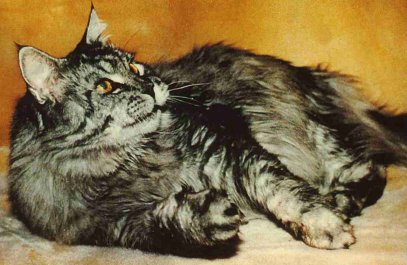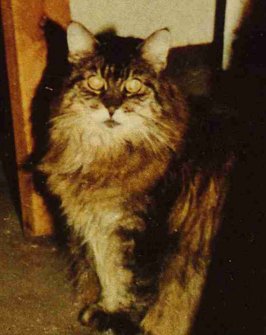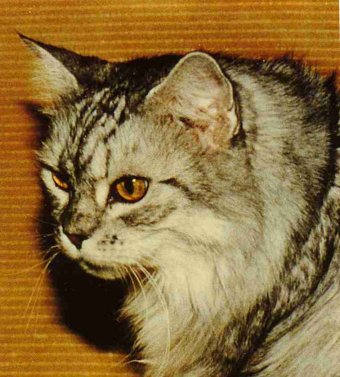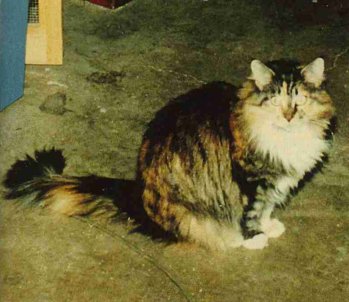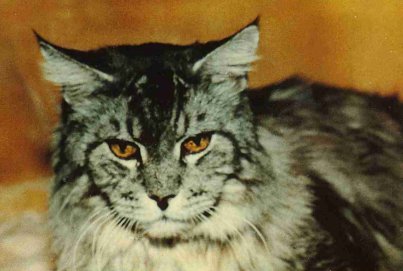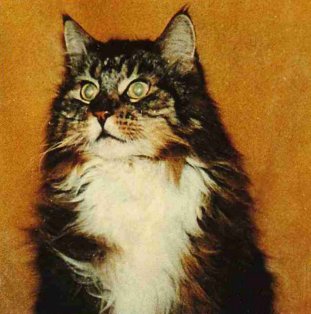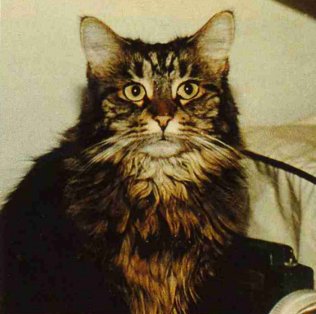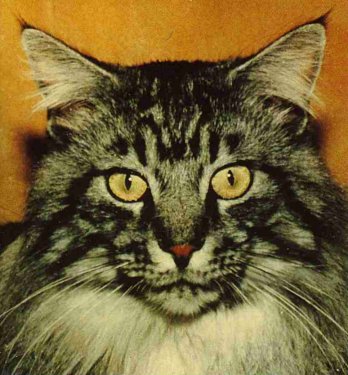| "This page was originally a part of the Maine Coon Heritage Site, a site that was first created in 1998 by Cynthia Bowen (Coontopia), Ulrika Olsson (Ylletrollets), Astrid Straver (Tricks and Tails) and Janet Marr (Furkats). It was then taken over by PawPeds, and it is now split up to fit better with the structure of PawPeds' website." |
 |
Connie Condit and her Heidi Ho Cattery
|
Henry |
No record of the Maine Coon cat is complete without the inclusion of Heidi Ho. We have published many of our photographs in a previous issue but are now fortunate enough to be able to include them with Lieutenant Colonel Mary (Connie) Condit's account, in her own words, of the history and progress of possibly the most famous Maine Coon cattery in the world.
Half expecting Connie's reaction to my request for an interview to be an enormous yawn ("Been there, done that, everyone knows all there is to know") I was amazed to meet with such a willing and enthusiastic response - and such a wealth of memories and anecdotes. After reading some of the stories we had previously published, she commented "The stories Kitty (Dieterich) and Bunty (Washburn) told brought back fond memories. I can still hear Kitty's horrified shriek when Abe began behaving like a true grandson of 'Horrible Henry'!" After that, the memories came thick and fast, building a picture of the Heidi Ho rarely seen by the public.
Connie was brought up with cats. "Though I don't remember the first one, a big grey neighborhood bum who would sneak into the house and snooze with me in my crib until Mother found him. The first one I remember was a red tabby shorthair, Tommy, who died young as a result of a fight with another tom. This was before anyone thought to neuter and spay. I spent summers with my grandparents on the farm where, at times, we had cats up to our ears until the annual panleukopaenia epidemic hit. There were no vaccines then."
|
Polly Adeline |
"There were many other cats in my life but none I could really claim until 1963, when a friend gave me a Siamese kitten. Popoki lived just a little over a year, when he died of some type of internal infection. He was followed immediately by Abner, another Siamese, who was joined shortly by Kim Chee, a Siamabby. I should say that, by 1963, I was in the Army Nurse Corps and subject to frequent relocations. I should have stopped with Abner and KC but I added a German Shepherd, Heidi Ho, and then Charlibrown. Next came Schroeder."
After this succession of pets and 'other breeds', Connie met the cats we all now feel we know so well - Andy Katt of Heidi Ho and Bridget Katt of Heidi Ho. She continues: "The first Maine Coon arrived in 1969, while I was teaching at Walter Reed Army School of Nursing. The school and dorm was targeted by a very pregnant little brown mac tabby as a good place to find a sucker! She found a whole bunch and, since I had a house with a spare bedroom (nursery!), I was elected to take her home. 'Susan' was not a Maine Coon. I don't know what she qualified for - she looked like Kliban's sneakers cat without shoes. Anyway, two weeks later, she presented us with four big boys - two black, one brown mac tabby and one brown mac tabby/white. Our 'unwed mother's fund' took care of Susan's shots and spaying and my mother took Susan, who lived with her for eleven years and then her final four years with me. Faculty members took the two black and the brown mac tabby boys, all shorthairs, and I decided to keep 'Andy', the brown mac tabby/white longhair."
"When Andy was about 6 months old, I met Bonnie Rich (de Richelieu cattery) and she went bonkers over him, insisting that I must register and show him - and breed him. I thought she was nuts, considering his mother and unknown father, but she explained foundation registration and, to get her off my back, I wrote to ACA and got him registered. I vaguely knew that a Maine Coon was a large, longhaired cat - because I had read an article about them by Jane Martinki in Cats magazine. Then Bonnie came back from a Florida vacation with Bridget to be his mate, even though I had told her emphatically that I was in no position to get involved with breeding cats!!"
|
Henrietta |
"I had also joined MCBFA to learn more about Maine Coons and was in touch with Betty Ljostad. I still thought Bonnie was out in left field but Betty suggested I bring Andy to an ACFA show in New Jersey and let the judges decide whether he was a Maine Coon. (Bridget was pregnant and couldn't go.) He came home a Champion. Three shows later, he was a Grand! (The rules were different way back then)."
She adds: "I've left out a lot of details but these are the basics of how I got my first Maine Coons. I guess you'd call it by accident. The cattery was named for my German Shepherd - she was totally involved in kitten rearing, right from birth: the cats loved her and she was a marvelous baby sitter."
After Connie's comment that she came into the breed more-or-less by accident, and had not intended to continue breeding, I asked her whether she then went looking for other cats the same, or whether she was looking to make any changes. Her reply: "Believe me, I did not go looking for any more cats! Moving the herd I had was difficult enough. One of Bridget's first litter went to a breeder in the Midwest, the others from this litter and from her second went to friends and family. When the third litter arrived, I had decided to do a little breeding (!), so kept the three girls, Heather, Molly and Fanny Abigail and two boys, Seth Parker and Henry Sayward, to interbreed them in order to weed out any bad genes. Those five were my breeders until I returned from Germany, at which point I brought in Polly Adeline (Tanstaafl) and Oquossoc (Ktaadn) to do some line breeding. I retired the old girls and also Henry and Seth, after I got Sonkey Bill from Henrietta and Henry. That breeding was taking a chance but one I decided to take because I had been away too long to have enough knowledge of breeders with males I might want to use and Henrietta was two years old and needing to be bred. I lucked out with Sonkey! I had also kept Becky for breeding - she brought Seth's genes for another generation."
"My breeding program was more by the seat of my pants than anything else. My main focus was on phenotype - if I could see it, I knew it was there. I didn't have room for wishful thinking. I had by then set my limit at 20 cats as the most I could properly care for and this included the retirees, as well as a few bums. (This crept up by one when Susan returned to live with us.) The most breeders I ever had at one time were two males and four females. The girls had one litter per year, except for a couple of times when Seth Parker managed to open the stud room door. Houdini was his middle name!"
|
Becky |
So - by now it seems that Connie had changed her mind about "not breeding" - and about "not looking for other cats"; so - back to the changes she might have liked to make: "There really wasn't much I wanted to change. Andy's nose break was a bit much and I corrected that with Bridget's. After that, it was more a question of maintaining status quo. I've never understood why people say they like a certain breed and then set out to change first one thing, then another. Years ago, a beginning breeder wrote to me for advice on her breeding program. She asked "What do the judges like?" My reply was very blunt: to H*** with what the judges like; breed to the standard! When I first started, very few judges knew a good Maine Coon when they fell over one!"
I then asked if Connie had made a decision to specialize in certain colours: "Not really. I guess my favourite colours are brown and silver tabbies and I prefer mackerel to classic. I also like torties and torbies in the females. My litters included most every colour, including cameos, which kept an element of surprise with each litter! More than colour or even type, I placed my emphasis on health and temperament. I thought of my cats first and foremost as companions - if I hadn't enjoyed that aspect, I wouldn't have kept them.' But what 'look' does she favour? 'I prefer the original look. The Clone look was taken to the extreme by too much close line breeding. The people who bred with clones would have done better to breed with good Maine Coon-type foundation cats to widen the gene pool. Often, when I'm visiting a show, the cats I mentally choose as the best do have Heidi Ho in their pedigree - seems most do! A couple of years ago, I really had a shock. I met Henry Sayward reincarnated from head to toe!!"
So here it was: 'the Clone look', straight from the horse's mouth! I asked about this phrase. "I don't know where the term 'Clone' came from. It was rather accurate. I can think of only one or two that weren't.' I then asked whether Connie had known from the beginning that the Sonkey/Polly mating would be so successful. "No, I didn't really know; just felt that it should. But I was not totally pleased with the way the clones matured; they were too lean and lanky and at least part of them were too fine-boned. They should have been bred to more outcrossed lines."
|
Henry |
Straying for a moment from the path of 'serious-breeder-questions', I asked Connie to fill in a little information on her lifestyle at the time. I had heard that she had moved around quite regularly and wondered how she managed to fit her cats and breeding into this type of life: "I started in Maryland and from there, went to Denver for a year; then to Fort Benning (Columbus), Georgia, for two and a half years; then to Stuttgart, Germany for two and a half years; and finally back here to Denver, when I retired." But how did the cats fit into this? "Not easily, but they were all good travelers. On our first move from Maryland to Denver, I piled 12 cats plus Heidi into my station wagon and told them to "sit down and shut up, we're going to Denver". Made just one stop at my mother's in Illinois, where I offloaded into my bedroom for three days, then on to Denver, where I had kennel spaces reserved until we could move into our own house. After that trip, I bought an 18ft travel trailer, divided it into boys' end and girls' end and, from then on, traveling was much easier. The transfer to Germany was a little more complicated but, thanks to much help from Betty and Rod Ljostad and Liz Eastman, it was accomplished with no disasters. Had a little problem convincing the Customs man in Frankfurt that I wasn't importing cats for sale but, after I instructed the airline clerk to tell him that "Some people collect stamps, I'm a nut that collects cats!", he waved us on through!"
"Wherever I was living, my cats lived underfoot. Of course, I had to arrange separate stud quarters. The 'its' commuted! Except in Germany, they had access to outside pens and, even there, the boys had access to a balcony, which I screened. After we retired here in Denver, I cat-proofed the entire backyard and built a secure 16 ft x 20 ft pen inside the yard for the boys. I believe that is one reason they were so healthy and had few birthing problems. Polly Adeline would be out in the yard climbing trees, the day before she popped out her 6 or 7 kittens. When the kids were around 6 weeks old, the mums would herd them up the ramp to the cat door window and take them all out to play."
We have heard conflicting impressions of the atmosphere at shows, in those days, and I asked Connie what she felt about the welcome - or otherwise - our breed received: "I think the shows were friendlier, then. We were the underdogs but, with the rather sketchy background of some of our foundation cats, we more-or- less expected it. Our goal was to breed to the standard until we weeded out the unwanted genes which had got in when the Maine Coons were left to breed on their own. I think we have now almost accomplished that. In looking through cat magazines, I find the Maine Coons now look like they belong to the same breed, which is more than I could say when I first started. I don't know that we were actually unpopular. No-one paid much attention to our cats until we began to make the finals and could produce a good sized entry. I attended many shows where my one or two were the only entries. That was especially true when I retired in Denver. I was never enthused about showing but felt that, as a breeder, I had an obligation to publicise our breed."
|
Jason |
And what of the attitude between the various Maine Coon breeders and owners at the time? "For the most part, they were a friendly bunch of people. We seemed to have common goals and welcomed newcomers. We had a fun time at showing and helped each other. It was not at all unusual to carry someone else's cat to the ring if we couldn't find the owner when his number was called and we all celebrated on the rare occasions when one of our cats made finals. As I said before, I think our cats now look as though they belong to the same breed and one of the big reasons for that is that in the early 70s we rewrote the standard and tried to be very specific. We gave everyone an opportunity to contribute their thoughts and then a designated committee worked for months to put it all into final form."
Returning to more specifically Heidi Ho-related questions, I then asked Connie more about her original breeding plans - whether she brought in more foundation cats for outcrosses or whether she preferred to go to other breeders' cats: "My only 'foundation cats' were Andy and Bridget, whom I still set as the cats from my household who had the most profound influence on the breed - after all, they started it all for me. At first, as I have said, I interbred some of their offspring, to bring out any 'bad genes' lurking in their unknown ancestry and, in doing this, I did uncover a cleft palate gene. Actually, there wasn't too much information readily available on genetic faults in cats so, knowing that cleft palate is genetic in humans, I assumed it would also be so in cats. Andy and Bridget produced a total of 19 healthy kids with no obvious faults. Interbred, they produced cleft palates. However, I sorted out the two males and three females mentioned earlier, who did not. These formed my 'production line' for the next 4 to 5 years and there was never another cleft palate, nor were any reported to me by those few people who obtained breeders from me. I think I pinned the faulty gene on Bridget. Bred to a son who had produced a cleft palate, she produced two in a litter of five. I couldn't check on Andy in the same way, since I didn't have a daughter who had produced a cleft palate and he had been neutered by the time I tested Bridget, due to a non-genetic health problem."
|
Chassanetta |
"After I retired and settled down having added Polly, Soc (Oquossoc), Becky and Sonkey, I retired Henry and Seth and kept mostly a closed cattery but I did give stud services to a few folks. A limited number of Polly and Sonkey's clones went as breeders."
Since Connie had so willingly discussed the cleft palate problem, I ventured to ask about other rumoured problems among the cats in those days. Who hasn't heard rumours and conjecture about the origins of some of the health concerns in our cats, even nowadays? She answered with the same honesty (and I took particular interest in the catalogue of ages at the end of her answer!). "The only hereditary health problem which was proven (at least to me) was the cleft palate and I believe I stopped that before it got beyond my own cattery. The two other problems, hypertrophic cardiomyopathy and pectus excavatum that the Heidi Ho line may carry, I have never seen among my own cats or kittens. I'm not sure where proper research stands on these, now. A friend who had one of the clones thought she had traced the pectus gene to one of Polly's ancestors, so Polly was retired. She was at the vet's being spayed the day Sonkey Bill dropped dead from cardiomyopathy - without any previous signs of illness. I tried for several years to get a firm answer to the hereditary factor but really never did. The only way I know to overcome these problems is to stop breeding the "culprit cat" and to warn anyone breeding with their offspring, which is what I did. I've never had hip dysplasia, either.
"The Heidi Ho kids that I have kept have been long-lived. The only ones who have died young have had malignancies. Polly was 18 when she died, last year, her daughter Becky is now 18, as is another line-bred girl and Sonkey's sister died last summer at 18. Henry was 17, Bridget 15, Jason 18 - and so on.' I wondered how much the average size of the Maine Coon had changed over the years. Connie estimates an average of 15-20 lbs for her boys, 10-15lbs for the girls. She doesn't believe that the same lines should be used ad infinitum, however reliable. She comments: 'I still think the stud book should be kept open but in a limited fashion. Right now, there is too much Heidi Ho in most lines; we need new blood transfusions."
|
Just Plain Bill |
And what of Connie's life now? Does she still keep in touch with the breeding world? Would she like to return to her close involvement? "In 1984, I decided to quit breeding, partly because it was getting too difficult to find responsible pet owners but mostly because I had increasing responsibilities in caring for an elderly mother, living in Illinois. But I still have cats, of course - 6 Maine Coons, plus four bums! I still keep in touch with many Maine Coon breeders and many still call me for a chat or to ask advice. It surprises me that people are still so interested in the Heidi Ho story!
"Life is a bit restricted, now, because of some old age health problems and I live in a house in a quiet residential area and find it much easier since I stopped breeding. Now I just run a geriatric ward! There are no actual Heidi Ho cats breeding anywhere, now - they are all too old and will have been retired years ago."
And finally; could Connie sum up in a few words her breeding career? No hesitation: "It was fun and interesting... but I don't want a re-run!!"
© "Maine Coon International", issue 7, 1996.
Reprinted with permission.

